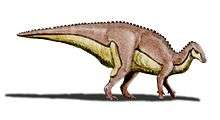Iguanacolossus
| Iguanacolossus | |
|---|---|
 | |
| Diagram showing the known fossil elements | |
| Scientific classification | |
| Kingdom: | Animalia |
| Phylum: | Chordata |
| Clade: | Dinosauria |
| Order: | †Ornithischia |
| Suborder: | †Ornithopoda |
| Clade: | †Styracosterna |
| Genus: | †Iguanacolossus McDonald et al., 2010 |
| Species | |
| |

Iguanacolossus (meaning 'iguana colossus' from the genus name Iguana and the Latin word "colossus") is a genus of herbivorous iguanodontian dinosaur. It is a basal iguanodontian which lived during the lower Cretaceous period (?lower Barremian age) in what is now Utah, United States. It is known from UMNH VP 20205, the associated partial skeleton of a single individual, recovered from the lower Yellow Cat Member of the Cedar Mountain Formation, dating to at least the early Barremian stage (about 130 million years ago).[1] Iguanacolossus was named by Andrew T. McDonald, James I. Kirkland, Donald D. DeBlieux, Scott K. Madsen, Jennifer Cavin, Andrew R. C. Milner, and Lukas Panzarin in 2010, along with the genus Hippodraco, also from the Cedar Mountain Formation. The type species of Iguanacolossus is I. fortis.[1] The specific name fortis means "mighty" in Latin.
References
- 1 2 McDonald AT, Kirkland JI, DeBlieux DD, Madsen SK, Cavin J, et al. (2010). "New Basal Iguanodonts from the Cedar Mountain Formation of Utah and the Evolution of Thumb-Spiked Dinosaurs". PLoS ONE. 5 (11): e14075. doi:10.1371/journal.pone.0014075. PMC 2989904. PMID 21124919.






